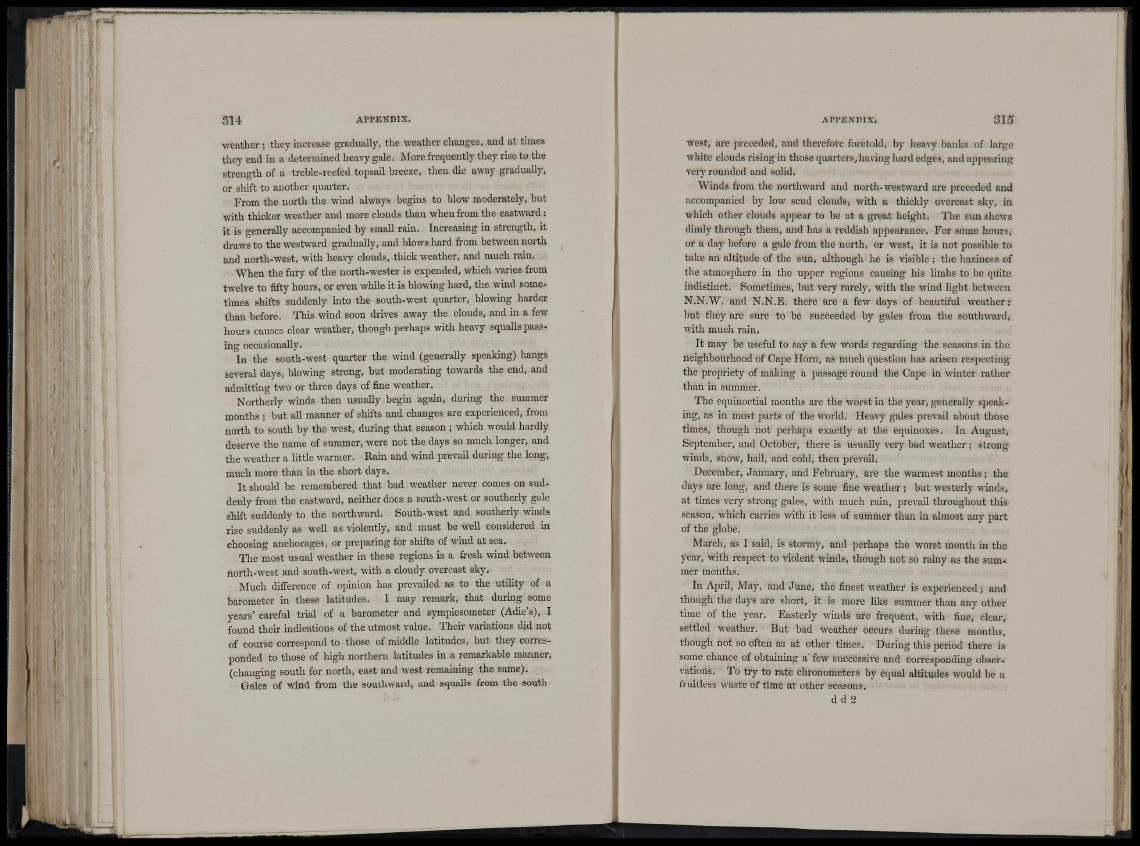
^ i ! I;-
314 APPENDIX.
weather ; they increase gi-adually, the weather changes, and at times
they end in a determined heavy gale. More frequently they rise to the
sti-ength of a treble-reefed topsail breeze, then die away gradually,
or sliift to another qiiarter.
From the north the wind always begins to blow moderately, but
with thicker weather and more clouds than when from the eastward:
it is generally accompanied by small rain. Increasing in strength, it
draws to the westward gi'adually, and blows hard from between north
and north-west, with hea^-y clouds, thick weather, and much rain.
When the fury of the north-wester is expended, which varies from
twelve to fifty hours, or even while it is blo-ning hard, the wind sometimes
shifts suddenly into the south-west quarter, blowing harder
than before. This wind soon drives away the clouds, and in a few
hours causes clear weather, though perhaps with heavy squalls passing
occasionally.
In the south-west quarter the wind (generally speaking) hangs
several days, blowing strong, but moderating towards the end, and
admitting two or three days of fine weather.
Northerly winds then usually begin again, during the summer
months ; but all manner of shifts and changes are experienced, from
north to south by the west, during that season ; which would hardly
deserve the name of summer, were not the days so much longer, and
the weather a little wanner. Rain and wind prevail during the long,
much more than in the short days.
It should be remembered that had weather never comes on suddenly
from the eastward, neither does a south-west or southerly gale
shift suddenly to the northward. South-west and southerly winds
rise suddenly as well as violently, and must be well considered in
choosing anchorages, or preparing for sliifts of wind at sea.
The most usual weather in these regions is a fresh wind bet^-een
north-west and south-west, with a cloudy overcast sky.
Much difference of opinion has prevailed as to the utility of a
barometer in these latitudes. I may remark, that during some
years' careful trial of a barometer and sympiesometer (Adie's), I
found their indications of the utmost value. Their variations did not
of course correspond to those of middle latitudes, but they corresponded
to those of high northern latitudes in a remarkable manner,
(changing south for north, east and west remaining the same).
Gales of wind from the southward, and squalls from the south-
Ari'ENTIX. 3 K
west, are preceded, and therefol-e foretold, by hea^y banks of large
white clouds rising in those quarters, having hard edges, and appearing
very rounded and soHd.
Winds from the northward and north-westward are preceded and
accompanied by low scud cloudsj with a thicldy overcast sky, in
which other clouds appear to be at a great height. Tlie sun shews
dimly through them, and has a reddish appearance. For some hours,
or a day before a gale from the north, or west, it is not possible to
take an altitude of the sun, although he is visible ; the haziness of
the atmosphere in the upper regions causing his limbs to be quite
indistinct. Sometimes, but very rarely, with the wind light between
N.N.W. and N.N.E. there are a few days of beautiful weather:
l)ut they are sure to be succeeded by gales from the southward,
with much rain.
It may be useful to say a few words regarding the seasons in the
neighbourhood of Cape Horn, as much question has arisen respecting
the propriety of making a passage round the Cape in winter rather
than in summer.
The equinoctial months are the worst in the year, generally speaking,
as in most parts of the world. Heavy gales prevail about those
times, though not perhaps exactly at the equinoxes. In August,
September, and October, there is usually very bad weather ; strong
winds, show, hail, and cold, then prevail.
December, Januaiy, and February, are the warmest months; the
days are long, and there is some fine weather ; but westerly winds,
at times very strong gales, with much rain, prevail throughout this
season, which cames with it less of summer than in almost any part
of the globe.
March, as I said, is stormy, and perhaps the worst month in the
year, with respect to ™lent winds, though not so rainy as the summer
months.
In April, May, and June, the finest weather is experienced; and
though the days are short, it is more like summer than any other
time of the year. Easterly winds are frequent, with fine, clear,
settled weather. But bad weather occurs during these months,
though not so often as at other times. During this period there is
some chance of obtaining a' few successive and corresponding observations.
To try to rate chronometers by equal altitudes would be a
fruitless waste of time at other seasons.
d d 2